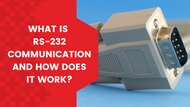What is RS-232 and How Does It Communicate Between Weighing Devices?
Posted by Seth V. on Jun 8th 2023
If you’ve ever physically connected a personal computer to a display, modem, printer, or any number of other external devices, chances are you’ve completed an RS-232 connection. But at Scales Plus, our expertise lies in weighing—not computing—so that’s the specific application we’re here to discuss.
In many instances, scale manufacturers offer a variety of plug-and-play solutions for their scale peripherals, and one of the most common standards of data transmission they include is RS-232.
But what can be done if your weighing setup doesn’t work right out of the box? In these instances, having a broader knowledge of communication equipment and the connections involved can be extremely helpful. So let’s get started!
WHAT IS RS-232?
Recommended Standard 232, or RS-232 for short, is a widely adopted standard for serial communication transmission of data. Invented back in 1960, the RS-232 connector is still a common sight in computer serial ports and peripheral devices to this day.
Compared to its successors—such as the RS-422, RS-485, and Ethernet—RS-232 communication exhibits slower transmission speeds, greater voltage swings, larger standard connectors, shorter maximum cable lengths, limited multidrop capability, and a lack of multipoint capability. And in the realm of modern PCs, USB has taken over the majority of RS-232's peripheral interface responsibilities.
Nevertheless, due to their simplicity and historical prevalence, RS-232 interfaces continue to find a role, especially in the areas of industrial machinery, networking devices, and scientific instruments where a short-range, point-to-point, low-speed wired data connection perfectly suffices. And as you may have guessed, this is exactly where industrial scales and laboratory balances come into play.
HOW DOES RS-232 COMMUNICATION WORK?
To understand RS-232, you first need to know what information it transmits. RS-232 works through low voltage that will not exceed 15 V. It communicates through serial bits, or ones and zeroes. These bits create commands, messages, error readings, and/or signal the start or end of a line.
Asserted and de-asserted control circuits determine these bits:
- Asserted control circuits represent the number zero and are associated with a +3 to +15 voltage.
- De-asserted control circuits represent the number one and are associated with a -15 to -3 voltage.
Next, the data or command communicates via a thread of information. This thread of information allows the scale to communicate weighing and other technical data to the peripheral device.
As you can see in the image below, the information thread consists of three parts:
WHAT ARE THE DIFFERENT TYPES OF RS-232 SCALE EQUIPMENT?
In RS-232 scale communication, there are generally four types of equipment:
- Data Terminal Equipment (DTE): This is usually the male connector with two rows of protruding pins. RS-232 DTE is the functional unit that initially reads, receives, and can send the data. In the scale industry, the DTE would be the indicator or scale itself.
- Data Circuit-terminating Equipment (DCE): This is generally the female connector with matching sockets to fit the male connector. RS-232 DCE is typically a modem or item that primarily receives the transmitted data, although it may still be capable of sending the data back to the DTE. In the scale industry, the DCE is often a printer, secondary display, or remote.
- RS-232 Cable: While the standard cable comes with a male and female end, you can find any combination to fit your unique setup. RS-232 cables typically come in lengths of 1–10 feet but can be up to 50 feet (or longer if its capacitance is less than 2500 pF).
- Null Modem: A null modem is also commonly used to connect two pieces of equipment through RS-232. Essentially, they swap the RxD (receive data signal lines) and TxD (transmit data signal lines) to enable handshaking between the two devices.
HOW DO YOU CONNECT AN RS-232 CABLE?
An RS-232 setup typically consists of a DTE and DCE connector and cable. The standard connectors for RS-232 are 9-pin or 25-pin configurations.
When connecting to a printer, the printer end commonly utilizes a 25-pin connector. A system with this configuration requires a DB-9 to DB-25 adapter or conversion cable. In the scale industry, it is almost always a 9-pin connector.
Sometimes, having the right connectors is only part of the solution. Null modems are required for two DTE devices to communicate via RS-232. The TxD of one DTE device would wire to the TxD of the second DTE device by "crossing over" using a null modem. The same is true for the RxD. Without the null modem to cross over the pinouts, no data would be transmitted.
FIND THE RS-232 EQUIPMENT YOU NEED AT SCALES PLUS
With all the information provided above, you should now be able to understand the basics of what RS-232 communication is and hopefully have an easier time connecting and troubleshooting your weighing equipment.
If you’re looking for replacement RS-232 cables (or any other communication cables), Scales Plus has you covered! We also carry a huge selection of scale printers, digital scale indicators, and other popular RS-232 scale accessories. And as always, if you have any questions about RS-232 connection or require further assistance with completing your weighing setup, please contact the experts at Scales Plus. We are always happy to help!








